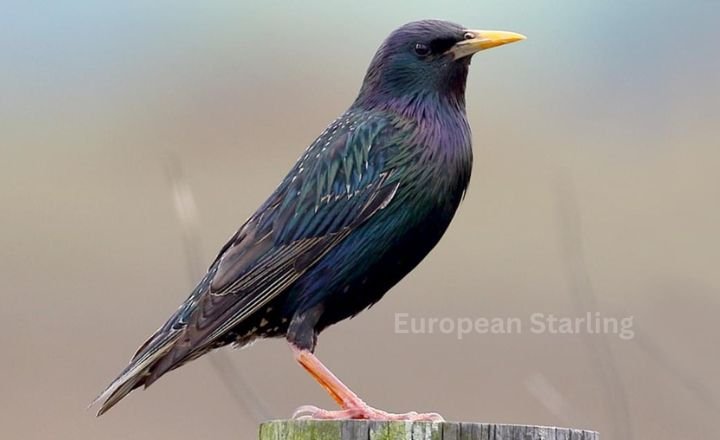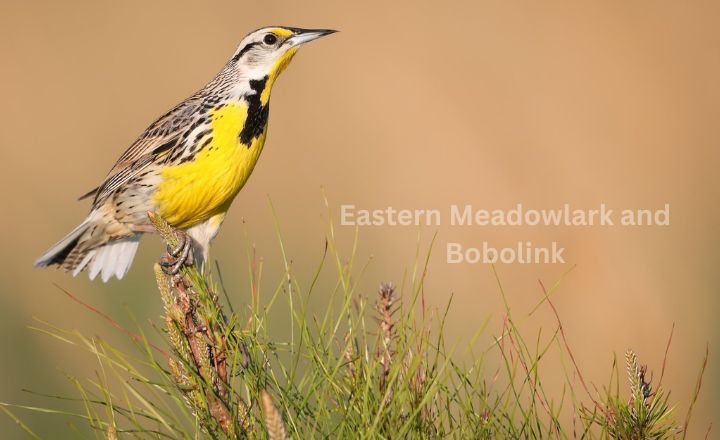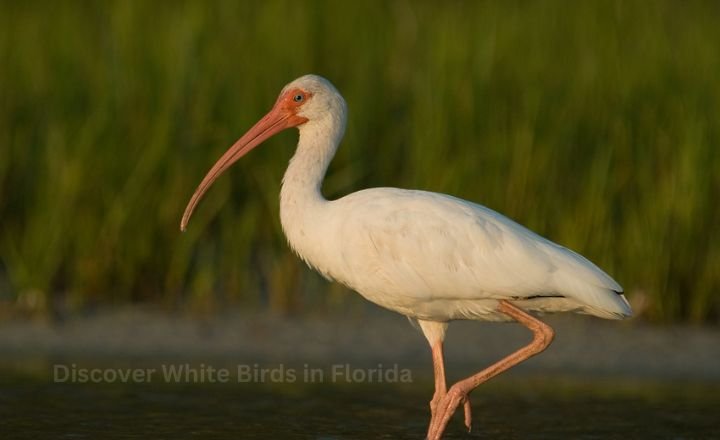16 Types Of Black Birds in Michigan
Black birds in Michigan have varied landscapes. Among them, black birds are particularly striking, their dark plumage contrasting beautifully against the vibrant backdrop of Michigan’s diverse ecosystems. From the sleek and elusive small black bird that flits through dense underbrush to those adorned with eye-catching accents like a small black bird with a yellow beak.
Red-winged Blackbird
The Red-winged Blackbird, a small black bird commonly found in Michigan, thrives in wetlands and marshes, showcasing a remarkable adaptability to various habitats. Characterised by its striking glossy black plumage and vivid red and yellow shoulder patches, this species is not only visually captivating but also plays a crucial role in local ecosystems.

What Do They Eat?
- Their diet primarily consists of insects, seeds, and various plant materials.
- During the breeding season, they particularly favour protein-rich insects such as beetles and caterpillars to feed their young.
- In colder months, red-winged blackbirds switch their diet to seeds and grains.
Where to Find Them?
- The captivating red-winged blackbird can often be spotted in diverse habitats in wetlands, marshes, and along shorelines.
- Their favourite spots typically feature dense cattails or tall grasses.
- Places like the Pointe Mouillee State Game Area offer ample opportunities to see these fascinating black birds.
Reproductive Patterns
- Males assert their dominance early in the season, singing from prominent perches to stake claim over their territories.
- Males establish their territory, a sound both familiar and exhilarating for those who wander near their nesting grounds.
- Their territorial displays often include fluttering flights showcasing their vibrant shoulder patches.
- By the time females arrive typically in April they’re greeted by a symphony of calls that range from melodic whistles to harsh squawks.
- As the female incubates her eggs, she relies on clever camouflage to protect her brood from predators lurking nearby.
Rusty Blackbird
This small black bird, adorned with subtle streaks of rusty brown, stands out beautifully against the backdrop of its monochromatic brethren. Unlike many of its all-black companions, such as the common Grackle or Red-winged Blackbird, the Rusty Blackbird showcases an intriguing twist with its striking yellow beak, a feature that captivates even seasoned birdwatchers.

- As habitats shift and climate conditions change, these elusive creatures have become increasingly difficult to spot during migration seasons.
- They favour wetlands and swampy areas where they forage for insects and seeds habitats that are dwindling due to urban expansion.
Five Fascinating Facts About Rusty Blackbirds Unique to Michigan
Rusty Blackbirds, a captivating species found in Michigan, have several unique traits that set them apart.
- They are known for their striking plumage, which features a distinctive rusty hue on their wings and back, making them easily recognizable during migration.
- These birds are often observed in large flocks, particularly during the winter months.
- Rusty Blackbirds primarily consume insects and seeds, showcasing their adaptability to different food sources depending on the season.
- Michigan’s diverse habitats provide essential breeding grounds for these birds, allowing for successful nesting in wooded areas near water bodies.
- Rusty Blackbirds are considered a species of concern due to population declines linked to habitat loss and environmental changes.
Other Common Black Birds Species in Michigan
The Common Grackle
Among the diverse array of black bird species in Michigan, The Common Grackle Known for their iridescent plumage that shimmers with hints of blue and green in the sunlight. These medium-sized birds can often be spotted foraging in open fields and parks. Their sociable nature is apparent as they gather in large flocks, often accompanied by other species such as red-winged blackbirds.

Brewer’s Blackbird
Another small black bird found across Michigan is the Brewer’s Blackbird, identifiable by its distinctively glossy body and slightly elevated tail. This species has an appealingly bold yellow eye that draws attention amidst its stark black feathers. Many enthusiasts delight at encountering this small black bird with a yellow beak, particularly during migration seasons when they blend harmoniously with songbirds. Their adaptability to urban environments makes them a common sight even in suburban backyards.

European Starling
One striking example is the European Starling, a small black bird that often dazzles with its glossy plumage and iridescent sheen. While these starlings are common throughout the state, their incredible ability to mimic calls can surprise even the most astute naturalists.

Brown-headed Cowbird
The Brown-headed Cowbird stands out as a unique brood parasite within Michigan’s ecosystems. Unlike most songbirds that nurture their young, this small black bird with yellow beak prefers to lay eggs in other birds’ nests, a behaviour that raises questions about evolutionary survival strategies and impacts on host species.

Baltimore Oriole and Orchard Oriole
The Baltimore Oriole and Orchard Oriole bring brightness to Michigan’s landscapes; their vibrant orange plumes provide an eye-catching contrast against green foliage. These orioles not only enrich our visual experience but also play vital roles in pollination and pest control underscoring how interconnected these black birds are within our environment.

Shiny Cowbird and Bullock’s Oriole
The Shiny Cowbird or Bullock’s Oriole; both species add layers of diversity to Michigan’s avifauna tapestry. The Shiny Cowbird might remain elusive due to its population fluctuations influenced by habitat changes whereas Bullock’s Oriole brings an exciting splash of colour alongside its melodious songs during migration seasons.

Black Birds of the Meadow: Eastern Meadowlark and Bobolink
In the rolling fields of Michigan, two striking black birds, the Eastern Meadowlark and the Bobolink grace the landscape with their distinct personalities and vibrant identities.
The Eastern Meadowlark, often mistaken for a mere shadow flitting through tall grasses, boasts a melodic call that resonates vividly against the backdrop of golden meadows. Its striking yellow breast is a vivid contrast to its dark plumage, making it one of those small black birds with a yellow beak that leave an unforgettable mark on anyone fortunate enough to catch a glimpse. Its song is not just a communication tool; it’s an invitation into its territory, revealing layers of emotion and playfulness that evoke a sense of connection to nature.

On the other hand, the Bobolink takes individuality to another level with its charmingly chaotic presence. Male Bobolinks showcase patchwork feathers reminiscent of an artist’s canvas, a blend of black wings and creamy tones that captures attention as they dart through fields in search of insects or seeds. Their boisterous calls create an orchestra among Michigan’s wetlands
Unusual Black Birds: Yellow-headed Blackbird and Hooded Oriole
The Yellow-headed Blackbird, a striking small black bird found in Michigan, boasts a stunning contrast between its glossy black body and vibrant yellow head. These birds prefer wetland habitats. Their unique nesting habits involve building intricate nests rafted atop floating vegetation, providing both safety from predators and an excellent vantage point for spotting potential threats. Observing their dazzling courtship displays during breeding season adds to the allure; males puff out their chests and sing melodically to attract females, creating a captivating showcase of nature’s artistry.

The Hooded Oriole presents a different charm with its vivid orange-yellow plumage that can easily draw attention against natural backdrops. Often spotted in Michigan’s deciduous woodlands or urban areas dotted with fruiting trees. This small black bird with a yellow beak exhibits remarkable adaptability. This species also shows an interesting nesting strategy: they weave hanging pouches from grasses that dangle from tree branches. Breeding pairs are known for their strong bonds; they often engage in synchronised feeding behaviours as they raise their chicks together.
The Western Meadowlark
The Western Meadowlark, often recognized by its striking yellow breast and melodious song, thrives in grasslands and open fields, where it utilizes its expressive vocalizations to establish territory during breeding season. These small black birds not only contribute to Michigan’s auditory landscape but also play a vital role in local agriculture by controlling pest populations.

Attracting Black Birds to Your Backyard in Michigan
Attracting black birds in Michigan backyard can be a rewarding experience, especially when you consider the variety of species that call this vibrant state home. One of the most delightful visitors is the small black bird with a yellow beak; likely a Common Yellowthroat or perhaps a young Black-capped Chickadee.
Provide a Variety of Bird Feeders
To attract black birds to your Michigan backyard, it’s essential to provide a diverse range of bird feeders that cater to their unique preferences. Consider using a mix of platform feeders, tube feeders, and suet cages filled with high-energy foods such as sunflower seeds and peanut pieces. The addition of specialised feeders for smaller species can entice the charming small black bird found in Michigan, like the Common Grackle or Red-winged Blackbird. Integrating feeders at varying heights allows both ground-foraging birds and those that prefer elevated feeding positions to thrive.
Create Suitable Nesting Habitats
Creating suitable nesting habitats is another key factor in encouraging these stunning visitors. Plant native shrubs and trees that produce berries like serviceberries or sumac to offer foraging options while also providing natural shelter. Using natural materials such as twigs, grasses, and leaves scattered around your yard can further promote nesting opportunities for small birds with distinctive yellow beaks seen fluttering through the region.
FAQs
What is a small black bird with a yellow beak?
Male Blackbirds are black with a bright orange-yellow beak and yellow eye-ring. Females are brown often with spots and streaks on their breasts and brown beak.
Are there black birds in Michigan?
Typically seen in Michigan during their spring and fall migration – January through March, October and November – the Rusty Blackbird is a winter resident of the eastern United States.
How many types of birds are in Michigan?
More than 450 bird species have been found in Michigan.
What are the black birds in Lake Michigan?
Cormorants are large, glossy black birds. They’re found all over North America and nest in the spring on remote islands in the Great Lakes. During the breeding season, their throats are bright orange and their eyes emerald green.
What kind of bird is black with a red stripe in Michigan?
Male red-winged blackbirds are easily identified by their glossy black coloring and bright orange-red shoulder patches; they typically arrive a few weeks before the females, who resemble larger, spotty-brown sparrows.







